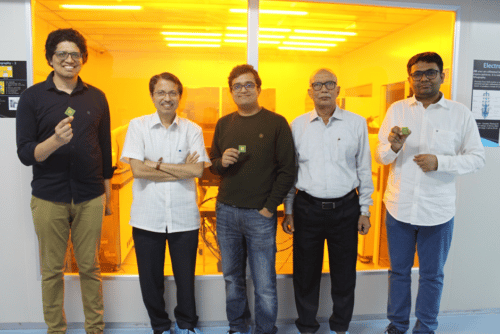Researchers at the Indian Institute of Science (IISc) have developed a new semiconductor solution to meet the energy demands of advance technologies.

Credits: CeNSE, IISc
As fast as the technology is advancing, its demand for data storage and therefore power requirement is also increasing. The demand for intelligent systems can only be sustained by an alternate approach to traditional electronic components is made to make them more energy efficient.
A team of researchers at the Centre for Nano Science and Engineering (CeNSE), IISc, have developed a highly energy-efficient computing platform that can help in the development of next-gen electronic devices. Researchers used memristors, instead of complementary metal-oxide semiconductors (CMOS), which are capable of storing data and are also capable of performing computational tasks. By designing unique memristors based on metal-organic complexes, the team could cut down the number of components needed in a circuit, greatly increasing the speed and efficiency.
“We have now discovered a molecular circuit element that can capture complex logic functions within itself, facilitating in-memory computations in a smaller number of time steps and using much fewer elements than usual,” says Sreetosh Goswami, Assistant Professor at CeNSE. Existing computing architectures process and store data at separate physical locations which consumes more energy while operating. “We are resolving this problem by performing both computation and storage at the same physical location,” he says.

The design of the new platform reduces the number of operational steps, increasing speed and reducing error, the researchers say. They used metal-organic complexes which are like “electron sponges that can take and give away electrons for billions of cycles without degradation,” to build this platform. They believe by making small chemical modifications – like, adding or swapping out one or two ions in the complexes, can adapt the same circuit for multiple functions.
The team compared the new device with a typical CMOS device and recorded that the new platform offered 47 times higher energy efficiency and 93 times faster operating speed, while only taking up 9% of the physical footprint. Moving forward, the team plans to connect the platform to a sensor – for example, a smartphone screen that senses touch – and study how efficiently the platform processes the data it collects.
References :
Yi SI, Rath SP, Deepak, Venkatesan T, Bhat N, Goswami S, Williams RS, Goswami S, Energy and Space Efficient Parallel Adder Using Molecular Memristors, Advanced Materials (2022). https://onlinelibrary.wiley.com/doi/10.1002/adma.202206128?af=R
Rath SP, Thompson D, Goswami S, Goswami S, Many‐Body Molecular Interactions in a Memristor, Advanced Materials (2022). https://onlinelibrary.wiley.com/doi/abs/10.1002/adma.202204551










THanks for the article, it was helpful.